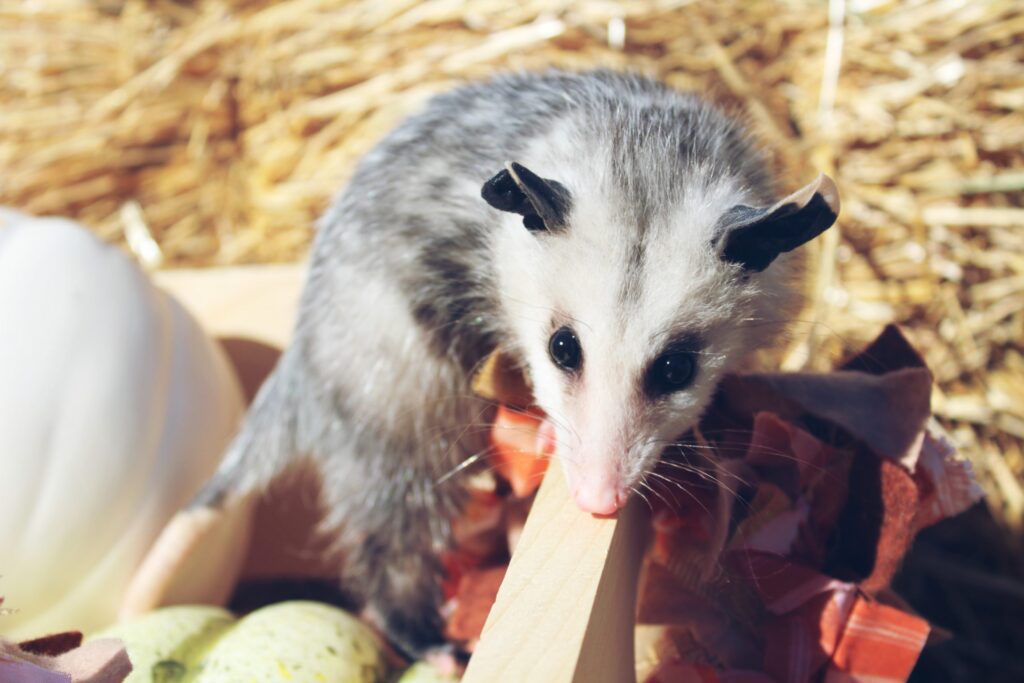The Virginia Opossum, also known as the North American Opossum, is a marsupial native to North and Central America. They are the only marsupial species found in North America. Virginia Opossums are known for their unique physical features, including a prehensile tail, sharp claws, and a hairless tail.

Physical Characteristics
Virginia Opossums have a distinct appearance with a long, pointed snout, and a triangular-shaped head. They have sharp claws on their feet, which are well-suited for climbing trees. Their fur is typically grayish-brown in color, and their tails are hairless and prehensile, meaning they can grasp and hold onto objects. Virginia Opossums are generally small, with males weighing up to 14 pounds and females weighing up to 8 pounds.
Habitat and Diet
Virginia Opossums are found throughout North and Central America, from Canada to Costa Rica. They are adaptable animals and can survive in a variety of habitats, including forests, grasslands, and urban areas. They are omnivores and will eat almost anything they can find, including fruits, insects, small animals, and carrion.
Lifespan
In the wild, Virginia opossums have a relatively short lifespan, typically living about 1.5 to 2 years. This brevity is largely due to predation and environmental challenges. Under human care, with controlled environments and regular food supply, they can live up to 4 years.
Common Opossum vs Virginia Opossum
While both the Common opossum (Didelphis marsupialis) and the Virginia opossum belong to the same genus, they exhibit notable differences:
- Geographical Range: The Virginia opossum is found throughout North and Central America, from Canada to Costa Rica. In contrast, the Common opossum inhabits regions from northeastern Mexico to Bolivia, including parts of the Caribbean.
- Physical Appearance: Both species have similar body structures, but the common opossum often has darker fur and more prominent black ears, leading to its nickname, the “black-eared opossum.”
- Habitat Preferences: The Virginia opossum is highly adaptable, residing in diverse environments such as forests, grasslands, and urban areas. The common opossum prefers tropical and subtropical forests but can also adapt to various habitats.
Virginia Opossum Sounds
Virginia opossums are generally quiet but produce specific sounds in certain situations:
- Hissing and Growling: When threatened or agitated, they emit hissing or low growling sounds to deter predators.
- Clicking: During the breeding season, males make clicking noises to attract females. Females also use clicking sounds to communicate with their young.
- Sneezing Sounds: Infant opossums may produce sneezing-like sounds, especially when seeking attention from their mother.
Behavior
Virginia Opossums are primarily nocturnal animals, meaning they are active at night. They are solitary animals and do not form social groups. When threatened, Virginia Opossums will often “play dead” by falling over and pretending to be lifeless. This behavior is an involuntary response to stress and is thought to help deter predators.
Conservation Status
Virginia Opossums are not considered to be endangered or threatened. They are common throughout their range, and their population is stable. However, like many wildlife species, they face threats from habitat loss and fragmentation, as well as from collisions with vehicles.
Fun Facts
Virginia Opossums have a lower body temperature than most other mammals, which makes them less susceptible to certain diseases, including rabies.
Baby opossums are called joeys and are born after a short gestation period of just 12 to 14 days. They spend the first few months of their lives inside their mother's pouch.
Virginia Opossums are good swimmers and can use their tails to help them navigate through water.
FAQ
Are virginia opossums dangerous?
Virginia opossums are generally harmless. While their hissing and open-mouth defensive postures might appear threatening, these behaviors are more about intimidation than aggression. Opossums are more likely to “play dead” when frightened than to attack humans or pets. They can carry certain diseases, so it’s wise to avoid direct contact. If opossums are frequenting your property, particularly at night, and you’re concerned about potential messes or disease, it’s best to contact professional wildlife removal services.
Are virginia opossums endangered?
Virginia opossums are not currently considered endangered. These adaptable creatures are widespread across North America, from southern Canada down to Central America, thriving in diverse habitats such as woodlands, farmlands, and even suburban areas. There are no significant threats that endanger their overall population at this time, making them a species of least concern in terms of conservation status.